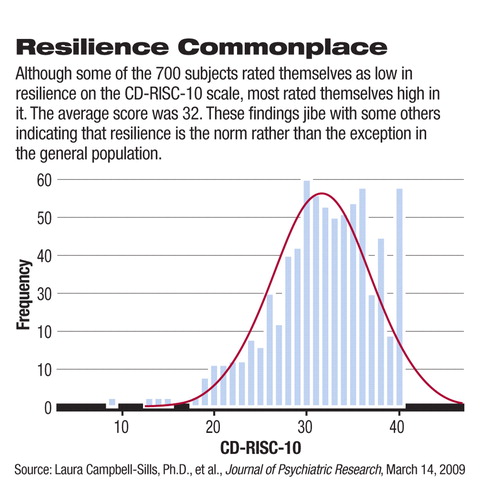Crime-Victim Survey Reveals Key Elements of Resilience
During the past few years, resilience—the ability to thrive in the face of stress or adversity—has become a hot research topic.
Having a reason for living, religious faith, meditation, exercise, and altruism have been found to help people cope with life's challenges (Psychiatric News, January 19, 2007; January 16). The NEO Five Factor Inventory is an instrument that measures, in subjects, the “big five” dimensions of personality—agreeableness, conscientiousness, extroversion, neuroticism, and openness to new experiences. Persons who are extroverted, conscientious, and open to new experiences according to this instrument tend to be more resilient than are persons who lack these personality traits. In contrast, individuals who are neurotic according to this instrument tend to be less resilient than are individuals who lack this personality trait.
Now a new study offers still more glimpses into resilience and factors that influence it. The study has found that most people consider themselves quite resilient, and especially males and especially those with higher education and income.
The study was headed by Laura Campbell-Sills, Ph.D., an assistant project scientist at the University of California, San Diego. Results were published online March 4 in the Journal of Psychiatric Research.

More than 700 individuals responded to a 2006 telephone survey on criminal victimization in Memphis, Tenn. The majority were female, with an average age of 48. Fifty-one percent were black, 47 percent white, and the rest Asian, Hispanic, or of another background. One of the instruments used in the survey was the Connor-Davidson Resilience Scale (the CD-RISC-10). Campbell-Sills and her coworkers tapped results from this scale, as well as demographic information about the respondents, to learn how resilient people in the survey considered themselves and to identify some of the factors that influenced their perceptions of their resilience.
The CD-RISC-10 asks an individual to rate himself or herself on 10 resilience items—for example, ability to adapt to change, ability to deal with unexpected events, ability to cope with illness and injury, ability to handle unpleasant feelings—on a scale of 0 (not true at all) to 4 (true all the time). Thus the lowest possible total score for the entire scale is 0 and the highest possible score 40. The total scores of the respondents in the Memphis telephone survey ranged anywhere from 9 to 40, with an average of 32. This means that most of these persons rated themselves as quite resilient. In fact, a minority (8 percent) rated themselves as being resilient nearly all the time.
Moreover, men rated themselves significantly higher than women did, and people with higher education or income significantly higher than persons of lower education and income. In other words, just as subjects' resilience scores increased with ascending levels of education, there was a similar effect of household income on resilience, with resilience scores increasing as income levels increased.
Still another instrument to which the surveyed individuals responded was the Childhood Trauma Questionnaire Short Form. Campbell-Sills and her coworkers used results from this instrument, as well as results from the CD-RISC-10, to see whether childhood trauma had any bearing on respondents' perceptions of their resilience. It did. Individuals who had experienced emotional abuse, sexual abuse, emotional neglect, or physical neglect reported significantly less resilience than did individuals who had not experienced such trauma, even after demographic variables were accounted for.
Finally, the researchers found that gender, education, and income explained only 11 percent and childhood maltreatment only 2 percent of the variance in subjects' resilience scores. So what other factors explained the remaining 87 percent? Personality traits, social support, and the number and degree of concurrent life stresses are possibilities, the researchers suggested. They did not explore these factors in their current study.
“I think that the finding that women scored lower than men on resilience may be surprising to some people,” Campbell-Sills told Psychiatric News. “On the one hand, this finding agrees with the extensive literature showing that women are more vulnerable to anxiety and mood disorders, which in some cases may be negative outcomes of exposure to stress. However, women certainly can be highly resilient. The fact that, on average, women perceive themselves as less resilient than men also may reflect reporting biases—for example, men may be less willing to express vulnerability to stress on a self-report scale.”
Campbell-Sills and her group are continuing to investigate resilience, she said. “Some of our areas of interest are using fMRI to examine how brain-activation patterns differ for individuals scoring low and high on resilience measures, looking at relationships between self-reported resilience and genetic polymorphisms, and investigating the relationship between resilience and individual differences in emotional regulation.”
The study was funded in part by the Memphis Shelby Crime Commission.
An abstract of “Demographic and Childhood Environmental Predictors of Resilience in a Community Sample” can be accessed at<www.sciencedirect.com> by clicking on “Browse by Title,” “J,” then“ Journal of Psychiatric Research Articles in Press.”▪



